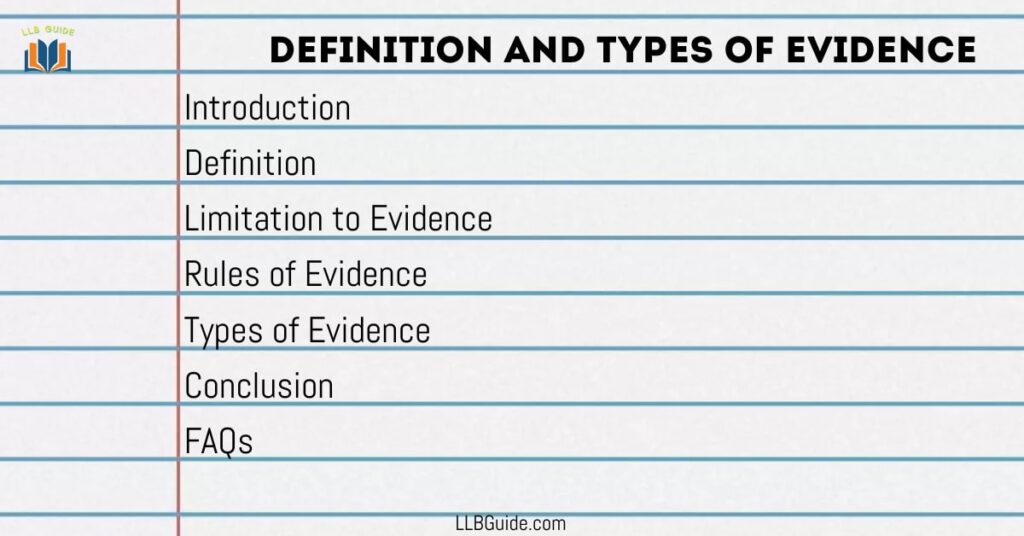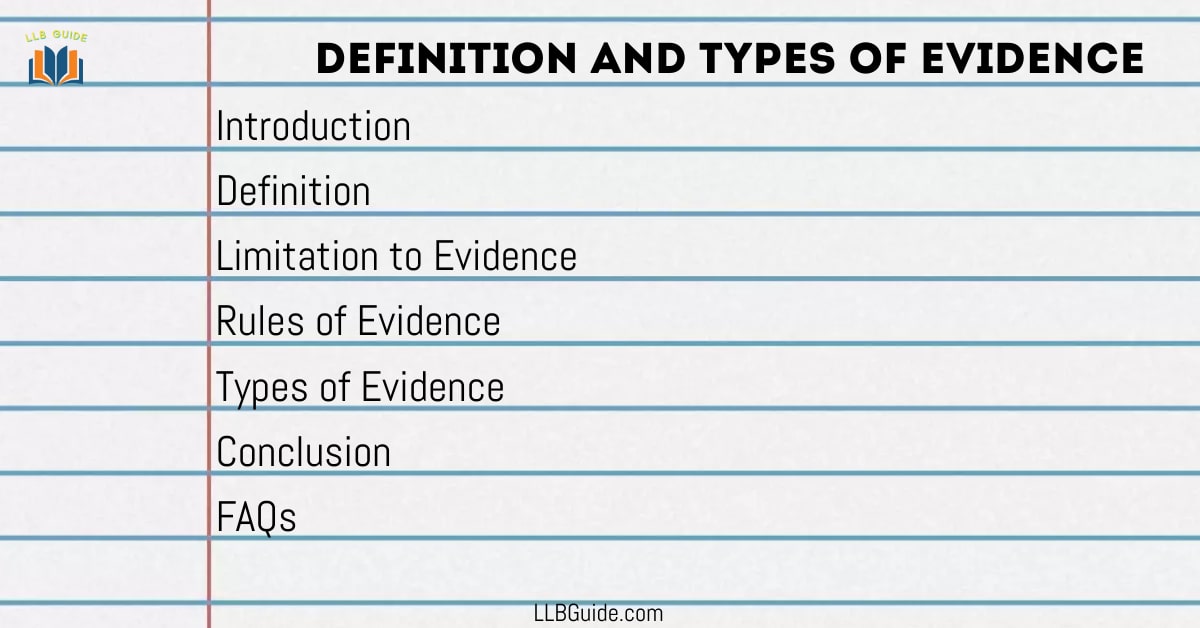Evidence and types of evidence are described in The Qanoon-e-Shahadat Ordinance 1984. Evidence means the production of any documents, statements, or objects before the Court and for the inspection of the Court regarding any matter pending before it.

Table of Contents
Definition And Types Of Evidence
The word ‘evidence’ is derived from the Latin word ‘evidentia‘ which means ‘obvious to the eye’. Evidence meaning in Urdu is ‘Shahadat’ which means testimony.
Definition of Evidence
Evidence is defined as under :
⦁ According to Salmond: Any fact that possesses probative force is called evidence.
⦁ According to QSO 1984: Evidence means and includes —
a. all statements that the Court permits or requires to be made before it by witnesses, in relation to matters of fact under inquiry, such statements are called oral evidence.
b. All documents produced for the inspection of the Court, such documents are called documentary evidence.
Limitation to Evidence
Privileged communications (article 4 to article 14) are the limitation of evidence given in QSO 1984, which is given below:
- Judges and Magistrates cannot be asked to give evidence except on their conduct or about anything that came to their knowledge as Judges or Magistrate,
- Communications during marriage come under privileged communications,
- Affairs of the state,
- Official communications,
- Information as to crime
- Professional communications,
- Bar applies to the interpreters or clerks,
- Privileged not waived by volunteering evidence,
- Confidential communications with legal advisers,
- Production of title deed of witness, not a party,
- Production of documents which another person having possession could refuse to produce,
Rules of Evidence
Some principles are used to assess the validity and fairness of evidence and types of evidence. These are mentioned below:
1. Valid
Evidence should always be valid. Valid evidence means
⦁ it should directly relate
2. Sufficient
Evidence is sufficient when:
⦁ it is complete
⦁ it satisfies all elements of the competency standard
3. Authentic
Evidence is authentic if:
⦁ it is based on assumptions
⦁ not on presumptions
4. Current
Evidence is current if it is:
⦁ very recent
⦁ not too old
Types of Evidence
Following are the various kinds or types of evidence that help to understand the meaning of evidence :
1. Original Evidence
The production of evidence in its original form is called original evidence. Documents public or private are usually produced as original evidence e.g. Marriage certificate. Original evidence is:
⦁ also known as primary evidence
⦁ it is the most prominent form of evidence
⦁ mostly related to documentary evidence
⦁ it is a reliable form of evidence
2. Unoriginal Evidence
Unoriginal evidence includes the production of copies of documents in place of original documents. Unoriginal evidence can be given when the original document is not available, lost, destroyed, or is in the possession of any person who is not willing to produce it or for some other reason.
⦁ also known as secondary evidence
⦁ it is considered insufficient evidence
3. Direct Evidence
Any evidence that is sufficient to determine the responsibility and relates to the real disputed question is called direct evidence. Direct evidence :
⦁ is oral in all cases
⦁ it can be documentary evidence too
4. Real Evidence
Production of any kind of material or object before the Court to prove the existence of such object or thing related to the question of the case is called Real evidence. Real evidence:
⦁ also known as material or physical evidence
5. Circumstantial Evidence
Any evidence which is based on presumptions or inference is called circumstantial evidence.
⦁ it includes hearsay evidence
6. Personal Evidence
Personal evidence means assumption-based evidence. When a person sees any incident and gives a statement about it in the Court, it is personal evidence.
7. Expert Opinion
Under Article 59 of Qanoon-e-Shahadat Order 1984, an expert is a person who has specialized knowledge or skill or expertise in any of
⦁ Foreign law
⦁ Science or Art e.g. computer forensics, DNA, etc
⦁ Identify of Handwriting
⦁ Identify finger impression
⦁ Electronic evidence
Conclusion
Evidence means testimony, all statements that the Court permits or requires to be made before it, are evidence. Types of evidence include original evidence, unoriginal evidence, direct evidence, real evidence, circumstantial evidence, and personal evidence.
FAQs
What is evidence?
An indication that makes something evident.
Why is hearsay evidence not admissible?
Hearsay evidence is based on presumptions or inferences. It does not confirm the credibility of facts, so it is not admissible.
What are the rules of evidence?
Rules of evidence include:
Valid
Sufficient
Authentic
Current
What is the most common type of evidence?
Direct evidence.
Dying Declaration is which type of evidence?
Dying declaration is Direct evidence.

